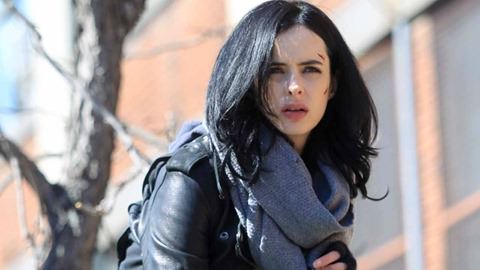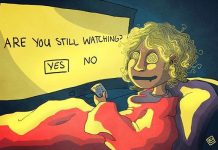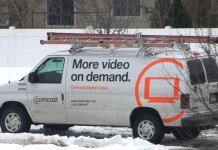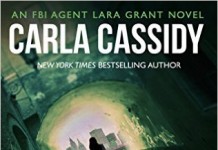 I just finished watching Jessica Jones via Netflix. It’s the second Netflix/Marvel original series, after Daredevil, and like Daredevil is available in its 13-episode entirety for binge-watching. And it’s really amazing. It features a compelling storyline and standout performances from its cast (especially David Tennant as the villain, proving that he isn’t letting his Doctor Who fame typecast him). Given that this isn’t a TV blog, I won’t go into it in detail, but suffice it to say that I agree with pretty much every word of this review of it on Forbes, which goes so far as to call it “the best show on TV” in its headline.
I just finished watching Jessica Jones via Netflix. It’s the second Netflix/Marvel original series, after Daredevil, and like Daredevil is available in its 13-episode entirety for binge-watching. And it’s really amazing. It features a compelling storyline and standout performances from its cast (especially David Tennant as the villain, proving that he isn’t letting his Doctor Who fame typecast him). Given that this isn’t a TV blog, I won’t go into it in detail, but suffice it to say that I agree with pretty much every word of this review of it on Forbes, which goes so far as to call it “the best show on TV” in its headline.
I particularly agree with these words:
Which raises the point, in case I didn’t make it clear enough earlier, that this isn’t a show you can watch with your children, or with anyone who is embarrassed or bothered by graphic content. There’s a lot of raw language, a lot of raw sex scenes, and an increasing amount of extremely disturbing violence (when someone gets dismembered, you see it shockingly up-close).
And so, much as Daredevil got me thinking about digital media ownership versus rental, the sheer grittiness of Jessica Jones got me thinking about the matter of gatekeepers in digital and print media in a broader sense—including the matter of books and e-books, which I’ll get to later. But to draw the parallel, I need to digress into television a little. You see, Netflix is a rather interesting special case.
For all that “broadcast” versus “cable” television is becoming an increasingly pointless distinction these days now that almost everybody gets their television either from cable or from Internet rebroadcast services such as Hulu, “broadcast” channels are still regulated differently from “cable or satellite” channels (and, by the same token, Internet subscription services like Netflix) when it comes to the FCC’s decency restrictions. The FCC’s consumer help center page about “Obscene, Indecent, and Profane Broadcasts” notes in part:
Congress has charged the Commission with enforcing the statutory prohibition against airing indecent programming “by means of radio communications.” The Commission has historically interpreted this restriction to apply to radio and television broadcasters and has never extended it to cover cable or satellite operators. In addition, because cable and satellite services are subscription-based, viewers of these services have greater control over the programming content that comes into their homes, whereas broadcast content traditionally has been available to any member of the public with a radio or television.
For that matter, a 2012 Supreme Court decision hamstrung some of the FCC’s decency enforcement criteria against “fleeting” indecency on the air. But even so, TV shows that air on broadcast TV are still subject to puritanical regulations that leave them pretty limited in terms of just how dark they can be. Even Arrow, probably the darkest, angstiest superhero show currently airing on broadcast TV, looks like a sulky teenager acting out by comparison to Jessica Jones.
Cable channels can go significantly darker and grittier—but they are handicapped by cable-industry bundling. To subscribe to any given pay channel, consumers generally have to subscribe to an extensive tier containing a number of channels, including ones they might have no interest in ever watching. For all that consumer groups and some service providers have argued for cable-industry unbundling, so far they’ve been remarkably resistant to change.
And that brings me to why Netflix is such a special case. It isn’t subject to expensive bundle deals. Consumers can subscribe to the wide variety of movies and television shows it airs for a single low monthly fee. And that includes original shows, which Netflix is able to make as dark and gritty as it wants. Effectively, Netflix isn’t subject to the puritanical gatekeeper of FCC decency restrictions, but it also isn’t subject to the budgetary gatekeeper of cable-industry bundles. So it’s one of the first major sources of dark, gritty programming that is inexpensively available to the average viewer. (Likewise, other streaming video services can produce shows traditional networks might not be willing to touch. Just look at Amazon’s production of a series about an alternate timeline in which the Nazis won World War II.)
A similar revolution has been happening in terms of self-publishing versus publisher gatekeepers. After all, the self-publishing industry experienced explosive growth partly on the strength of providing a way for writers to publish works in categories that often draw resistance from traditional gatekeepers—romance, erotica, erotic horror, political fiction, and others. While Amazon has been known to purge certain categories of self-published erotica from time to time, there are still quite a number of stories that could never have been published by a traditional publisher, but which have plenty of fans willing to buy them via Amazon, Smashwords, or other outlets.
For that matter, digital music services have also provided a way for artists to skirt the gatekeepers of recording-industry contracts and radio stations’ limited playlists to put their works out directly for consumers. I know I’d never have run across artists like Waterflame, Black Gryph0n, Ken Ashcorp, The Axis of Awesome, or many others or if I were stuck listening to the same old radio stations instead of using music services that could recommend me new music similar to other music I already like.
And this leads me to the realization that there are quite a few areas of consumer media interest that have historically been poorly-served by traditional outlets. People are not only willing to consume but clearly actively want to consume works that traditional gatekeepers have shut out—be they for raunchiness, violence, esoteric subject matter, more than one of the above, or some other reason altogether. Thus, the reductions in publishing cost and regulation of digital media, including e-books, provide openings not only for self-publishing writers and artists, but for new media outlets like Netflix that don’t fall into the same old categories.
And yet I wonder if we’re truly only seeing the beginning of the sort of expansion of choice that digital media publishing opportunities make possible. So far, it feels like these sorts of successes have been based on a “push” model—authors create works that they haven’t been able to get published before, and then find out whether there is demand for them. People throw something new at the wall and see what sticks and what slides off.
This certainly works for authors who have new ideas that they want to push and see if readers like them, but it’s not so effective when people would like to see particular new things that aren’t out there because nobody’s produced any yet. You simply can’t buy non-gatekept works if those non-gatekept works don’t exist yet for you to buy. You need some kind of a “pull” model for that—a way consumers can express desire for stories in a more focused and effective way than just blogging that it would be nice if those kinds of stories existed.
What if there were some kind of writer’s market for commissioning (and perhaps crowdfunding?) new works on particular themes, the way that fans can commission artists to draw sketches of their favorite characters? Would such a thing work, or fizzle? I suppose we won’t know until and unless someone tries it.
But meanwhile, this is still a really great time for people who haven’t been all that well-served by the traditional distribution channels in the past. People can read self-published books on subjects traditional publishers would never have touched. And I wouldn’t have been able to see something as dark and gritty as Daredevil or Jessica Jones this easily in the past—they’d have required subscribing to cable, waiting for the DVDs, or using less kosher methods to acquire.
I can hardly wait to see what comes out next.


































Personally I don’t think a ‘pull’ model will ever work because the audience is not creative enough to publish what they want in terms that would appeal to the creatives. If they were they would be writing content rather than merely looking for it.
A form of the “pull” model Chris describes has existed for some time, but it is generally limited to brands or media franchises with an established, passionate base. Fans of TV programs have often petitioned major networks to revive or rework cancelled programs. In the 70s, Star Trek fans turned a show with mediocre ratings into a cultural phenomenon and begged Paramount and Gene Roddenberry to make a Star Trek movie. The studios understood the mass audience potential and the Star Trek franchise was born. More recently, the cancellation of Veronica Mars series and the lack of interest in a feature film version by movie studios led producer/writer Rob Thomas to launch a Kickstarter campaign, which allowed fans to “pull” the concept off the shelf with financing, in a manner of speaking. As for original material without an established fan base, you could argue that any production of look-alike or sound-alike material is an indirect response to audience demand for “more like that.” The spate of dystopian movies roughly imitating Hunger Games might be an example.